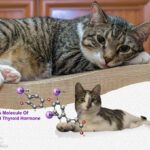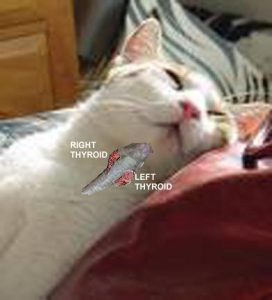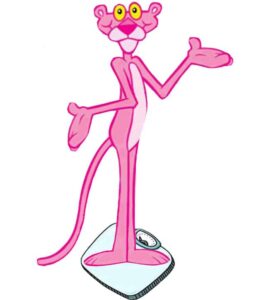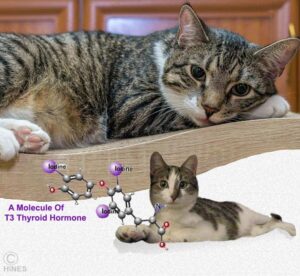Hyperthyroidism In Your Cat – Its Cause And Its Treatment
Ron Hines DVM PhD
 To learn about low-iodine diets for hyperthyroid cats, go here
To learn about low-iodine diets for hyperthyroid cats, go here
 To learn how to cook for your cat, go here
To learn how to cook for your cat, go here
 Do all cats with hyperthyroidism require the same radioiodine dose?
Do all cats with hyperthyroidism require the same radioiodine dose?
 Meds That Might Interfere With Your Cat’s Thyroid Gland Test Results
Meds That Might Interfere With Your Cat’s Thyroid Gland Test Results
Your cat’s thyroid glands regulate the speed at which your cat’s body metabolism works – much like the accelerator on your vehicle regulates the speed of your car. It does this by producing a hormone called thyroxine or T-4 that regulates the speed of all body processes. When your cat produces too much of it and its metabolic engine sores, it has become hyperthyroid. The opposite situation, hypothyroidism (low T-4) is very uncommon in cats but common in dogs. When hypothyroidism does occur in cats, it is usually in a kitten that was born a dwarf. (read here & here)
Hyperthyroidism is the most common hormonal abnormality that affects cats. It tends to be a disease of older cats. The most common age at which veterinarians tend to first diagnose it is between 8–13 years. Nine out of ten cats that develop hyperthyroidism are said to be over ten years old.
Your cat’s thyroid is actually a pair of glands. In humans, it is a united two-lobe gland. Your cat’s thyroid glands are located on the underside of its neck along its wind pipe (trachea). I drew them in my imaginary picture at the top of this page, somewhat larger than they really are, for visual effect.
Is This A Form of Thyroid Cancer?
Feline hyperthyroidism is usually not a malignancy. Less than three percent of the cats that develop hyperthyroidism are though to develop malignant thyroid tumors. In over 98%, of cases, the cells in the whole gland (or portions of it) are just producing too much thyroid hormone. The scientific name for what is occurring is “functional thyroid adenomatous hyperplasia”. In about eight out of ten cats with this problem, both of your cat’s thyroid glands are affected.
What Kind Of Cats Develop This Problem?
As I mentioned, hyperthyroidism is typically a disease of older cats. However, it can occur at an earlier age – although that is quite rare. We think of pampered house cats when we think of this disease. But it could well be that pampered cats just get more frequent veterinary examinations. Although veterinarians traditionally thought that hyperthyroidism affected male and female cats with equal frequency, it may actually be more common in female cats  , just as hyperthyroidism in humans is more common in women, for unknown reasons.
, just as hyperthyroidism in humans is more common in women, for unknown reasons.
More About Your Cat’s Thyroid Glands
Your cat has two distinct thyroid glands on either side of its windpipe midway down its neck (see my top right image). In us humans, it is a single gland with a left and a right lobe. This gland is responsible for regulating the speed of all chemical reactions that occur within your cat’s body (your pet’s basal metabolic rate). Its thyroid glands produce two hormones that are disbursed through its bloodstream to every cell in its body. These hormones are triiodothyronine (T3) and thyroxine (T4). The more of these hormones that the thyroid glands produce, the higher your cat’s metabolic rate will be and the more calories it will burn. That is one reason hypothyroid cats tend to be quite thin. Of the two hormones, the effects of high T3 levels is the most dramatic. In people, even mood is affected, perhaps that occurs in cats as well. we do not know. (read here)
What Signs Might I See If My Cat Becomes Hyperthyroid?
As I mentioned, excess thyroid hormones affect every organ of the body. Your pet’s kidneys, liver, muscles, heart, nervous and digestive system are all over-stimulated. That leads to a number of physical changes you can see. Rarely does any one cat show all of the signs that veterinarians associate with the disease. The signs that do occur in your cat all begin quite gradually. As time passes, they become more obvious.
Weight Loss
The most common complaint that brings hyperthyroid cats to their veterinarian is weight loss. These cats remind me of the Pink Panther – they are lean in the extreme. Perceptive owners notice that although their cats are losing weight, their appetite is normal or even increased. That is because the pet’s metabolic rate has accelerated, and it is using up food calories just as fast as it can consume them. You might hear them munching late into the night and complaining when their food dish is empty. However, when cats have reached the late severe stages of this disease, their general health often deteriorates to the point that they don’t have much appetite at all. Occasional cats develop a form of this disease called “apathetic or masked hyperthyroidism” in which they appear listless and apathetic (disinterested). As I mentioned earlier, high thyroid hormone levels probably also affects the brain. Those “brain fog” cats might also have less of an appetite than they once had.
Increased Activity And Restlessness
Many hyperthyroid cats appear jittery (nervous), as if they had taken a stimulant. They are often overly restless and hyperactive. A few appear more cranky or even aggressive. Some are said to have disturbed sleep patterns.
Poor Hair Coat
Many hyperthyroid cats appear unkempt. Some no longer groom themselves as well as they used to. Others over-groom themselves to the point where their hair coats are thin or ragged. A lack of interest in grooming might be noticeable through mats that form on long-haired cats. Of course, many of the health issues that affect older cats affect their interest in grooming too.
A Fast Heart Rate
It is very common for hyperthyroid cats to have an abnormally fast heart beat. Your cat’s normal relaxed heart rate at home should be about 140 to 200 beats per minute. Many cats with hyperthyroidism have heart rates of over 200 even when they are relaxed at home. Your cat’s heart beat will usually be considerably faster (= tachycardia) at an animal hospital due to fear. Regardless of your animal hospital’s “Fear Free” policy, the same goes for your cat’s blood pressure. Cats can’t read.
Increased Drinking And Increased Urination
This is also a common occurrence in hyperthyroidism. Your cat’s increased thirst is due to the increased thyroxine in its system. Its increased urine production is due to its increased water intake.
Vomiting
We do not know why some cats with hyperthyroidism vomit. It sometimes occurs in hyperthyroid humans as well. (read here) Perhaps it is due to the increased amounts of food they eat, or perhaps to the direct effects of their high thyroxine levels on stomach motility and portions of the brain.
Diarrhea
The increased level of thyroid hormone in hyperthyroid cats causes their intestines to be more active. This is why many of these cats have bulky or loose stools. The odor of your cat’s litter box may be considerably worse than it used to be, and trips to the box might be more frequent. Since thyroid issues and kidney issues are closely entwined in cats, either or both could be the underlying cause(s) of changes in litter box visits.
Panting Or Difficulty Breathing
Hyperthyroid cats generate more body heat and may pant as they try to dissipate it. (read here) Taking the temperature of a mellow cat at home with the aid of a second experienced person is not that difficult, but please be careful, I do not want you to get clawed or bitten. Your cat might also be more sensitive to heat than it once was. If a cat reaches a point in the disease where its heart function is affected, panting and difficulty breathing is more likely due to problems obtaining sufficient oxygen. As with your cat’s blood pressure and heart rate, your cat is more likely to run a bit hotter (its temp up) when in a non-home setting.
Weakness And Listlessness
In the later stages of hyperthyroidism, multiple factors often cause cats to become debilitated and weak. Muscle tremors, wasting, an anemic (abnormally quiet) meow and generalized weakness can all be symptoms of advanced hyperthyroidism – although they could also be symptoms of disease to numerous for me to list. Supplemental vitamin B-6 is said to help with this problems in humans with hyperthyroidism, and some suggest that it might be helpful to cats. However, too much B-6 can also be toxic, so I would prefer you provide a name brand multivitamin designed for cats, given at the dosage suggested on the label. Pet-Tabs® would be fine.
A Low-Grade Fever
I already mentioned that fever can account for panting in cats, and that the high metabolic rate of hyperthyroid cats sometimes causes them to have mildly elevated rectal temperatures (103 F/ 39.4 C). I also mentioned that a rectal temperature of 103 F can easily be generated by a visit to your veterinarian simply because of fear and stress (both your cat’s and yours since you key off of each other). It is the exceptionally rare cat that looks forward to strange people and strange quarters. Not only the (to you) imperceptible lingering odor of dogs are unappreciated by felines; the lingering odors of strange cats can be even more upsetting to them.
Lumps And Nodules In The Neck, In The Area Of The Thyroid Glands
In normal cats, the lobes of its thyroid gland cannot be felt with one’s fingers when you feel your cat’s neck. In hyperthyroid cats, at least one lobe can be larger than it should be and can be felt. You or your veterinarian may be able to detect this, or small, pea-sized nodules, within the glands. Many older cats do have lumps in their thyroid glands, but not all of them are hyperthyroid – yet. If your veterinarian detects any mass in your cat’s thyroid area, it is prudent (desirable) to run the T-4 test and a blood calcium measurement. Some of these masses turn out to be located in the parathyroid glands that are adjacent to the thyroids. The parathyroid glands are involved in the regulation of body and blood calcium level.
What Tests Will Tell My Veterinarian If My Cat Is Hyperthyroid?
If your veterinarian is suspicious that your cat might have hyperthyroidism, he/she will order a T-4 blood test. Many vets include a T4 test on yearly “wellness” visits and cats over a certain age (often 8-9 yrs). If the T4 levels in your cat are markedly higher than they should be for its age group, the diagnosis has been made. Your vet will probably suggest checking your cat’s blood pressure as well, since high blood pressure is common in cats with thyroid problems. Most vets would include an abbreviate blood chemistry panel as well. (see here) In those blood panel results, mild-to-moderately elevated liver test panel AP and/or ALT levels are not unusual. They are quite helpful in decision-making when your cat’s T4 test is borderline. (ask me for Nix2016) When the T-4 results in your cat are on the borderline between normal and abnormal, your vet might also order the free T4 test I mentioned earlier, or a more sophisticated test called a T-3 suppression test. The suppression test requires giving your cat a tablet three times a day for two days before the blood test. This test is rarely performed. Positive results with this test will identify many hyperthyroid cats that are missed when only the T-4 tests are run.
There is still a sizable group of hyperthyroid cats that veterinarians have trouble identifying with either of those two tests. That is because a cat’s level of T-4 and T-3 fluctuate during the day, and sometimes the sample was taken when they were lower and in the normal range. Repeat the -4/T-3 tests usually identify these cats. However, other diseases that have nothing directly to do with your cat’s thyroid gland can influence its thyroid test results. (read here)
If the results are still borderline and inconclusive but the results of other tests involving the liver, heart, kidney, or muscle are abnormal, a thyroid scan probably needs to be performed. Particularly if your cat is losing weight. In this test, your cat is given an injection of a small amount of a radioactive element called technetium. Then an image similar to an x-ray is taken to find out where the material traveled. Technetium has an affinity for glands and tends to concentrate in them. If more is seen in the thyroid image than there should be, the cat is almost certainly hyperthyroid. This test allows the radiologist to actually see your cat’s thyroid gland and locate areas of problem within it. This test can also pick up the few cats with malignant thyroid tumors or those that might be cured surgically. It will also identify the extremely few cats that have misplaced thyroid tissue somewhere else in their bodies.The technetium test requires equipment that most veterinarians do not possess. If your veterinarian is suspicious that a borderline high or normal T4 test is due to the pet having another medical problem that masks hyperthyroid tests, your vet might decide to have an Equilibrium Dialysis Free T-4 test run before sending you to a facility large enough to run the technetium test. The Equilibrium Free T-4 test often identifies hyperthyroid cats that are sick with multiple diseases that give a falsely low T-4 reading. Cost-related limitations and individual veterinary philosophies make it likely that you would be offered to just try a few weeks on a thyroid medication such as methimazole (Tapazole®, Felimazole®) to observe if your cat improves. That approach is just as legitimate.
Why Might Hyperthyroidism Be Becoming More Common?
Veterinarians are unsure. But here are some things we do know: Veterinarians did not notice that house cats were developing hyperthyroidism in greater numbers until after 1979. Curiously, that was about the time that whales and herring gulls in the St. Laurence Seaway, and cormorants in Tokyo Bay began developing similar thyroid problems. Both these areas are highly polluted with industrial chemicals. There are two chemicals that have been suspected as being the root of this problem. The most recent one added to the list are polybrominated diphenyl ethers (PBDEs). Since the 1970s, they have increasingly contaminated our environment. PBDEs are flame retardants used in building materials, electronics, furnishing, motor vehicles, airplanes, plastics, polyurethane foams and textiles. PBDEs are found in particularly high concentrations in fish that are high up the food chain. (read here) Bi-products from these fish end up in seafood-flavor cat foods as well as the indoor environment. (read here & here) Others disagree. (read here)
The second possible culprit is a chemical called bisphenol-A (BPA) which is used to coat the inside of cat food cans. It appears that alternative can coatings are gradually taking BPA’s place. We know from a 2000 EPA study that cats that eat canned foods – particularly those that have fish flavor, are more susceptible to hyperthyroidism. (read here) The authors theorized that it might be the BPA can lining that accounted for this – but at the time the article was written, we did not appreciate the additional link between fish, high PBDE levels and hyperthyroidism. All the industrial compounds for which suspicions exist that they can produce endocrine gland disease are called endocrine disruptors. Read about some of them that make their way into your cat here.
It may be that, with time, pet foods will be screened for PBDEs and similar toxic substances. But for now, do not feed your cats canned or dry, fish-flavored cat foods. If you feed your cats fish, avoid fish like salmon and whitefish that are known to concentrate this chemical. Not all cats that develop hyperthyroidism eat fish products. The EPA veterinarians who conducted the study pointed out that PBDE’s have become so common in our homes that it is impossible to avoid some exposure to them.
If consuming a diet high in iodine predisposes your cat to hyperthyroidism remains unknown. You can read more about the possible role of iodine in thyroid disease in cats here.
Why Might My Cat’s Kidneys Be Affected By Hyperthyroidism?
Veterinarians have known for a long time that many hyperthyroid cats have masked (inapparent) kidney disease as well. We do not know if hyperthyroidism is the cause of the reduced ability of their kidneys to cleans their body, or if this is just a separate disease occurring in older cats. High blood pressure is thought by many veterinarians to be damaging to your cat’s kidneys. We know that hyperthyroidism is associated with high blood pressure (hypertension). (read here)
We also know that hyperthyroidism allows cats with kidney issues to keep their blood flushed cleaner of wastes (e.g., creatinine) than they could if they were not also hyperthyroid. That is because hyperthyroid cats usually drink and urinate more. Their abnormally high thyroid hormone levels and the abnormally high blood pressure that sometimes accompanies hyperthyroidism actually help these cat’s kidneys do their work. But once hyperthyroidism is controlled with drugs or cured with radiation, and the cat’s water consumption returns to normal, its underlying kidney problems often become more apparent – or worse.
So if your veterinarian suspects that your hyperthyroid cat has significant kidney damage, it might be wise to treat it first with methimazole (Tapazole® USA), carbimazole (Neomercazole® UK, etc.) for a while to see how its kidneys perform when its thyroid is under control before contemplating surgery, radioiodine treatment or lifelong medications. I believe that starting with a low dose, lower than many veterinarians currently use, and increasing the dose very slowly over many weeks is the best way to approach this. In this way, the pet’s kidneys may have time to adjust. If the cat’s BUN and creatinine rise unacceptably high, it is probably better to maintain the cat at some level of hyperthyroidism rather than return its thyroid hormone levels to normal.
Why Might My Cat’s Heart Be Affected By Hyperthyroidism?
Unfortunately, when hyperthyroidism is detected late in the disease, some cats already have some degree of heart damage. In hyperthyroidism, the added thyroxine causes their heart to beat faster and more forcefully. With time, the left lower side of the heart compensates by becoming thicker. (their left ventricle) The condition is similar but not the same as hypertrophic cardiomyopathy. (& read here) The best way to diagnose this problem is with a cardiac doppler ultrasound exam. The electrocardiogram (EKG) of cats with thyroid-related heart problems might also be abnormal. Left untreated, the cat’s heart will eventually fail. Most cats that receive medication or radiation treatment for their thyroid problem return to satisfactory heart function. But when a cat is brought in late in the disease, the pet may need heart support before its thyroid problem can be dealt with. Another complication that occasionally occurs when the cat’s heart is failing are blood clots that often affect a cat’s ability to walk (saddle thrombi).
Effects On Your Cat’s Blood Pressure?
Yes.
I already mentioned the dangers of high blood pressure (hypertension) and the challenges of obtaining accurate animal hospital readings, but also that it is quite common for hyperthyroid cats to have true elevated blood pressure. Hyperthyroid cats often have systolic pressures above 190 mm Hg, even when they are relaxed at home. A number of problems can occur when their blood pressure is that high. Tiny blood vessels in the cat’s eyes, kidneys, and brain can burst under the increased pressure, damaging those organs. Retinal detachment and blindness sometimes occur in hypertensive cats. Veterinarians have several medications to reduce high blood pressure in cats when it occurs (e.g., amlodipine Norvasc®). Often, these drugs are no longer needed once your cat’s thyroid problems have been solved.
What Treatment Options Available For My Cat?
Hyperthyroidism is not a condition you should ignore. It can be treated medically, radiologically and sometimes surgically. However, I suggest you have your cat treated radiologically if you can afford it because over time, cats treated radiologically do so much better than those treated medically and only a few cats are good candidates for surgery. Your cat’s age also needs to be an important factor in your decision. Elderly hyperthyroid cats treated medically are just as likely to pass away from other diseases such as lymphoma and other cancers or non-related heart or kidney failure as they are to die from hyperthyroid-related problems.
Medications That Will Help:
Two closely related medications, methimazole and carbimazole are very effective in preventing excessive thyroid hormone production. Methimazole is relatively inexpensive. Unfortunately, every cat requires its own customized dose and the difference between too high a dose, too low a dose and the right dose is small. So cats going this rout run the larger expense of frequent thyroid hormone level checks to be certain their dose is working correctly. In most cats, twice-a-day dosing is required. But the optimal dose frequency ranges from 1 to 3 times a day. Your cat is safest if the dose is begun low (lower than some veterinarians might recommend) and gradually increased until the desired effect is obtained. The return of lost lean body weight is a very important factor in my recommendations to clients.
The human-formulated form of methimazole is sold as Tapazole®. One veterinary-formulated form is called Felimazole®. Methimazole has an awful taste. Cats usually hate it (sometimes vomit and make a fuss). Felimazole® tablets have a sugar-coating that blocks the drug’s taste. So if your cat is doing poorly when given generic or human methimazole, either try the coated veterinary tablets or purchase it compounded as a transdermal ear cream or gel. (read here) The problem with custom compounding and transdermal medications in general is that there is a wide range in the absorption of the creams and gels – depending on who prepared them, how they are applied, ear vascularity, and the presence of ear irritation. Inflamed ears actually absorb more of the drug these products contain, not less.
Unfortunately, some cat owners report that their cats eat less when on either of these oral medications. Vomiting and lethargy are not uncommon, and it can be very difficult to administer this bitter pill. Lowering the dose and then increasing it again very gradually sometimes avoids some of these side effects. These bitter medicines must be given for the rest of your cat’s life. After a while, your cat might become quite displeased with you. Occasionally, these medications produce side effects which include diarrhea, liver damage and bone marrow suppression. So periodic blood tests need to be run. A few cats develop skin irritation. But when side effects do not occur or resolve during the first three or four months on the medication, cats generally do well for a number of years on either drug. Some cats receive methimazole prior to thyroid surgery to improve their heart function and make them safer candidates for anesthesia. Others receive them prior to proposed radioiodine therapy to test the true ability of their kidneys to function once normal T4 levels are restored. Quality of life issues for your cat, for you and for your household, not just hyperthyroidism, need to be considered when deciding to administer or not administer these drugs. Only you, not your veterinarian, are in a position to make those decisions.
A Low Iodine Diet
Iodine is a necessary ingredient for your cat to produce thyroid hormones. Your cat gets that required iodine from the things it eats. When less iodine is present in your cat’s diet, it will produce less of the hormones involved in hyperthyroidism. Hills Prescription Diets manufactures a product called y/d®. It is designed to lower your pet’s thyroid hormone level by limiting the amount of iodine it consumes. It is also possible to prepare a lower iodine diet at home. You can read about low iodine diets here.
Procedures That Help
Radioiodine therapy
I mentioned that radioiodine therapy is my treatment of choice for hyperthyroid cats in certain age groups. A 2006 study found that cats that were treated with radioactive iodine lived, on average, twice as long (2 vs. 4 years) as cats treated with methimazole. (read here) This procedure, when performed correctly, is safe. But because it involves the handling of government-regulated radioactive materials, it is only attempted at specialized veterinary centers. When the procedure is successful – and it usually is – your pet should need no further treatments or medications. In this procedure, a single injection of radioactive Iodine-131 is given to your cat subcutaneously or intravenously. Occasionally, a second dose is required. Because iodine migrates to your cat’s thyroid gland, the concentration of this special iodine within the thyroid glands becomes great enough to kill the overactive cells that are utilizing iodine to produce excess thyroid hormone. Usually, enough normal and dormant cells are left to make all the thyroid hormone your cat will need in the future. But it is said that about 5% of the radioiodine treated cats will need daily, life-long supplemental thyroid hormone (levothyroxine/Soloxine®) in crushed or pill form after the procedure. That medication has no objectionable taste. There have been no serious side effects from this procedure that I know of. It is not painful, and your cat does not need to be anesthetized. However, your cat will need to stay at the hospital facility until the radiation that is released has subsided. Radioiodine is also the preferred treatment method for humans who are hyperthyroid. (read here) An occasional rare cat has misplaced thyroid tissue in other areas of its body (ectopic tissue). Unlike surgery, radioiodine treatment eliminates any ectopic (out-of-place) thyroid tissue as a potential contributing problem as well.
How Much Does Iodine Treatment For A Cat Cost?
Many cat owners are of the mistaken opinion that radioiodine therapy is more expensive than lifelong treatment with methimazole. It is true that methimazole tablets are relatively inexpensive. But the number of thyroid hormone level checks for dose adjustments and repeat visits to your veterinarian will make up for this. Besides, radioiodine treatment gives consistently better results in cats than managing the condition with medications. The cost of radioiodine therapy varies widely between facilities in the United States and Europe. A casual look on the internet some years ago found the cost running from $785 in Arkansas to $1,700 in the New Jersey/New York area. Costs in Canada are generally a bit lower than in the USA. In Belgium, it was a bargain. The University of Gent one time offered the procedure for €320 ($446). So, it is very wise to check a number of facilities within your driving distance when planning this treatment for your cat. If your cat has had radioiodine treatment recently or if you have recently inquired, please let me know what the cost was and the general area where you live, and I will add it here.
Surgical Partial Or Total Thyroidectomy
Surgical removal of the diseased portions of your cat’s thyroid glands is occasionally another option. But during the surgery, the difficult decision must be made as to how much of your cat’s thyroid glands to remove. There is no precise way for your veterinarian to make this decision. If too much of the cat’s thyroids are removed, the cat will become hypothyroid and need lifelong thyroid medication (levothyroxine). If too little of the glands are removed, your cat will remain hyperthyroid. Sometimes it is appropriate to remove all of the thyroid. Cats are thought to usually have small islands of thyroid tissue scattered in other locations in their bodies. These “ectopic thyroid cells” can usually produce all the thyroid hormone your cat will need. But they can also lead to the re-appearance of hyperthyroidism months or years later. We know little about this. Thyroid glands are in a sensitive, crowded location. If the adjoining parathyroid glands are injured during surgery, your cat may have trouble regulating its blood calcium level. If nerves in the area are injured, your cat might develop eye problems or voice changes. (horner’s syndrome) Most veterinarians stabilize cats with methimazole for a number of weeks prior to this surgery. Some remove a conservative amount of thyroid in a first operation and then monitor the cat’s T-4 and blood calcium level for a while before deciding if a second surgery is required to remove more. Even when performed by an experienced surgeon and with excellent post-surgical monitoring, the fatality rate of this surgery can approach 10%. You can expect the cost of this surgery to be equal or more than radioiodine therapy and to have less predictable results.
You are on the Vetspace animal health website
Visiting the products that you see displayed on this website help pay the cost of keeping these articles on the Internet.





